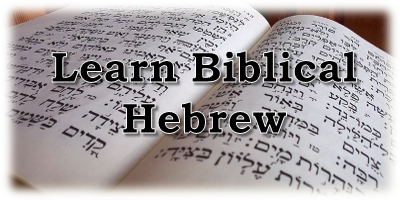Consonants
| ת | The "Tav" is pronounced "t" as in tune. A dagesh may appear in the letter but will not change the sound of the letter. |
| ד | The "dalet" is pronounced "d" as in dig. |
Vowels
| אֱ | The Hhataf Segol. This vowel is a combination of the Segol and Sheva vowels. This vowel is pronounced "eh" as in elephant, but it is pronounced very softly. |
| אֹ | The Hholam. This vowel is a dot which appears at the top and just to the left of the letter instead of beneath it and is pronounced "o" as in open. |
Notes
The Hebrew word for Moses (Vocabulary word #1) appears to be missing a vowel after the "mem". Since Hebrew requires a vowel after each consonant, the vowel is the "o" placed above the letter "Shin". The dot over the right leg of the letter "Shin" and the vowel "o" are in the same place.
The "et" (Vocabulary word #3) precedes a definite direct object of the verb and is rarely translated into English. For example, if I said "I made the dinner", the definite direct object is "the dinner" because "the" comes before "dinner". In this case the Hebrew word "et" would precede "the dinner" in Hebrew. If I said "I made a dinner", the "et" would not precede it since "dinner" in this sentence is not a definite direct object.
An exception to the rule requiring the C-V-C-V pattern is the word "reshiyt" (Vocabulary word #8). The aleph does not always require a vowel after it.
The dagesh will commonly be found in some letters such as the shin (see sentence #2) and the tav (see sentence #5). In the Sephardic pronunciation these dagesh have no impact on the pronunciation and can be ignored.
Practice
Vocabulary
| Moses | מֹשֶׁה |
| God, gods (Masc. Noun) | אֱלֹהִים |
| Precedes the definite object of the verb | אֶת |
| Gave (Masc. Verb) | נָתַן |
| Sabbath | שַׁבַּת |
| Teaching (Fef. Noun) | תוֹרָה |
| To us | לָנוּ |
| Beginning | רֵאשִׁית |
| Student (m) (Masc. Noun) | תַלמִיד |
| Student (Fem. Noun) | תַלְמִידָה |
| Study (Masc. Participle) | לוֹמֵד |
| Study (Fem. Participle) | לוֹמֶדֶת |
Sentences
| Peaceful Sabbath. | שַׁבַּת שָׁלוֹם |
| And they will keep the Sabbath. | וְשָׁמְרוּ אֶת הַשַׁבַּת |
| Moses gave to us the Torah. | נָתַן מֹשֶׁה לָנוּ אֶת הַתוֹרָה |
| In [the] beginning God created. | בְּרֵאשִׁית בָּרָא אֱלֹהִים |
| A student studies the Torah. | תַלמִיד לוֹמֵד אֶת הַתוֹרָה |
| A student studies Torah. | תַלְמִידָה לוֹמֶדֶת תוֹרָה |



